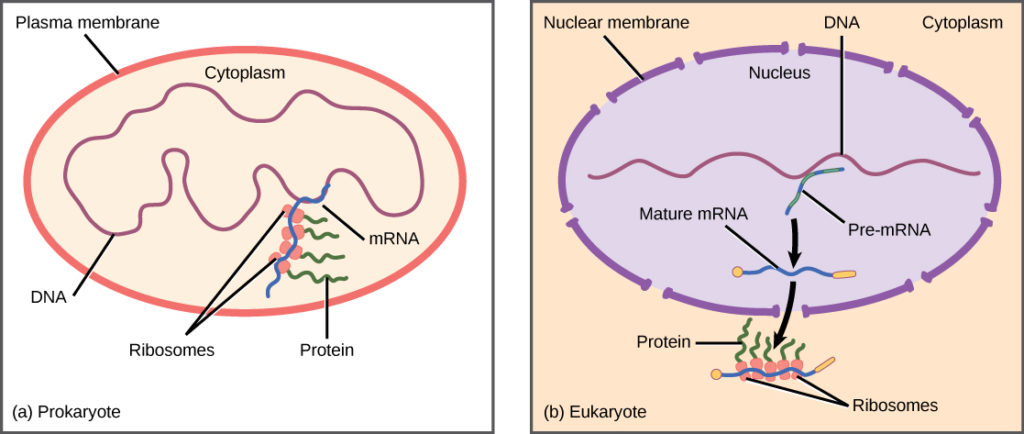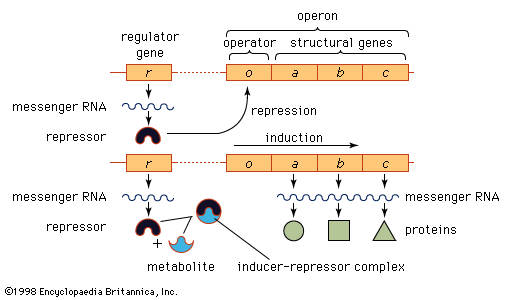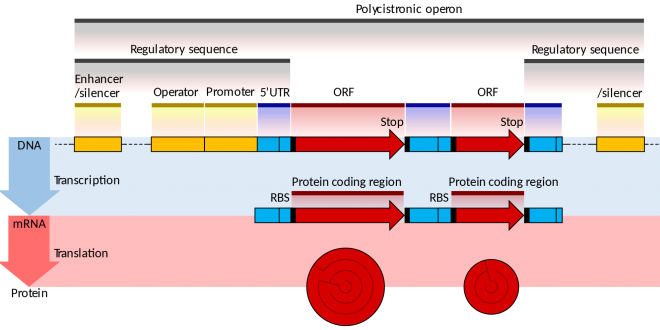Every cell of an organism possesses all the structural genes or cistrons. The genes produce proteins and control the activities of the organism. But a genetic system doesn’t allow them to function all at a time in order to avoid enzymatic chaos. Many gene products are only needed occasionally by the cell. This genes produce proteins when they are needed by the cell or the substrate on which they act is present. In eukaryotes, only a few genes are functional and all other genes are permanently nonfunctional. On the other hand prokaryotes such as E. coli (Escherichia coli) bacterium expresses only some of its genes at any given time out of the total of about three thousand genes.
Various types of mechanisms control and regulate the expression of genes present in cell. The regulatory genetic system turns the genes active when needed and turns them inactive when not needed. These regulatory genetic system which control the process of turning on a gene to produce RNA and protein is called Gene Regulation.

Regulation of Gene Expression in Prokaryotes
Best safe and secure cloud storage with password protection
Get Envato Elements, Prime Video, Hotstar and Netflix For Free
Best Money Earning Website 100$ Day
#1 Top ranking article submission website
Prokaryotic organisms lack a well developed nucleus and they are usually single celled. As DNA floats freely within cytoplasm of the cell, the processes of transcription and translation occur almost simultaneously. Transcription stops when there is no need of producing more proteins. The regulatory system of transcription controls the protein production and how much of each protein is expressed in the cell. If more protein production is needed, more transcription will occur. Thus, the regulation of gene expression works in prokaryotic cells. This gene regulation model was developed by Jacob and Monod.

General Features of Gene Regulation in Prokaryotes
- In prokaryotic cells, the regulation of gene expression usually occurs at the transcriptional level.
- It occurs within the cytoplasm as prokaryotic cells lack of a defined nucleus.
- It can also occur during the termination or elongation steps of transcription.
- It regulates the amount of protein production from the indicated gene.
- In response to different environmental conditions, prokaryotic cells have evolved to be able to regulate gene expression.
- There are two majors kinds of proteins that control prokaryotic transcription: repressors and activators.
- This regulatory system uses Operon Model as functional units.

Opreron Model (Source here) - Three types of Opreron are used. They are Arabinose operon, Tryptophan operon and Lactose operon.
- No proofreading occurs, so mRNA goes to make proteins directly.
- This system causes inhibitor to make repressor which bind to operon.
- Those genes involved in this system are structural, operator, promoter and regulator. These all are matching genes.
- Those enzymes involved in the system are beta galactosidase, galactosidase permease, transacetylase and RNA polymerase etc.
- Gene regulation in prokaryotes is simpler than in eukaryotes.
Significance of Gene Regulation in Prokaryotes
- Gene regulation system helps to synthesize the necessary proteins at the right time which is very important for the cell to function properly.
- Gene regulation is very important for viruses, bacteria and other prokaryotes.
- It helps to encode proteins that will be produced only when required and thus avoid cellular enzymatic chaos.
- It increases the adaptability and the versatility of an organism.
References & Other Links
- https//:courses.lumenlearning.com
- www.opentextbc.com
- www.biologydiscussion.com
Written by
Tubaia Zannat Juthi, B.S. (Hons), Department of Botany, University of Dhaka
Revised by
- Md. Siddiq Hasan on 28 July, 2020.
Best safe and secure cloud storage with password protection
Get Envato Elements, Prime Video, Hotstar and Netflix For Free
 Plantlet The Blogging Platform of Department of Botany, University of Dhaka
Plantlet The Blogging Platform of Department of Botany, University of Dhaka





